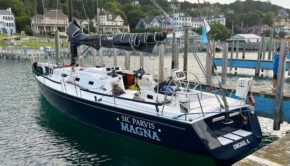Offshore lake sailing to Mackinac
Published on July 18th, 2018
by Bernie Wilson, Associated Press
Doug DeVos remembers sailing along “fat, dumb and happy” under spinnaker in 15 knots of wind on Lake Michigan in last year’s Chicago Yacht Club Race to Mackinac when his 86-foot maxi Windquest suffered a knockdown punch.
In a matter of minutes, the wind had grown to 40 knots, blowing the yacht on its side, with the boom in the water, until the spinnaker blew up and the crew was able to regain control. Damage forced Windquest out of the race, one of the nearly 100 boats that had to retire.
Still, that’s not going to keep DeVos from returning for his 38th Chicago to Mackinac this weekend, the 110th sailing of the world’s oldest annual freshwater distance race.
“Sailing is a beautiful sport of long, tedious boredom intermixed with moments of stark terror,” DeVos said, summing up last year’s experience and the conditions the Great Lakes can throw at competitors, seemingly at any time.
The race of roughly 290 nautical miles begins on Lake Michigan just off Chicago’s Navy Pier and ends on the other side of the Mackinac Bridge near small, picturesque Mackinac Island on Lake Huron.
The start of the cruising division is July 20, with the racing division starting Saturday, July 21. Windquest will be in the Turbo Division, the last fleet to start Saturday. The bigger boats usually fly through the slower fleets.
The Chicago to Mackinac is called “America’s Offshore Challenge,” and sailors who shrug off the fact that it’s on a lake sometimes pay the price. None other than Ted Turner — who would be nicknamed “The Mouth of the South” and “Captain Outrageous” on his way to winning the America’s Cup in 1977 — reportedly called Lake Michigan a “mill pond” before his first Chicago to Mackinac in 1970. Turner’s 12-meter was pounded by strong wind and waves, and legend has it he recanted his dismissive comments on the spot.
DeVos is the president of Amway, the brother-in-law of U.S. Education Secretary Betsy DeVos and one of three principal financial backers for American Magic, the New York Yacht Club’s team for the 2021 America’s Cup.
He grew up sailing on Lake Michigan and understands why sailors keep coming back.
“Because of the personal connection, growing up in this area, it has an allure to it that’s pretty powerful,” DeVos said. “The race has just enough surprises to keep you on the edge of your seat and keep you coming back.”
Sometimes there’s too much wind, sometimes not enough.
“It just happens to be on a very big lake that can exacerbate the situation,” DeVos said. “There are summer storms that take you by surprise. It’s amazing how quickly it can go from flat to rough, and it can stay that way.
“I’ve dealt with a lot of folks who shake their head like, ‘I never expected anything like that.’ ”
In 2011, two sailors died after their boat capsized in a storm during the race. U.S. Sailing later determined the boat was not suited for the competition because its sails were too big for its weight.
Sarah Renz, chair of the race committee, said the Chicago to Mackinac is invitational, and every boat is reviewed for the experience of the crew and stability index of each boat.
More than 300 boats and nearly 3,000 sailors are entered in this year’s race. Sailors come from 16 countries and 39 states.
“It’s a bucket list race for a lot of people, but also a local race,” Renz said. “You do one race as your bucket list race and do it again because every one is different.”
She’ll be sailing in it for the 17th time.
Peter Isler, who twice won the America’s Cup with Dennis Conner, will be part of Windquest’s crew of 19.
For many reasons, the Great Lakes “are a special body of water for those of us used to sailing on oceans and in saltwater,” Isler said.
“They’re big,” he said, noting that the rhumbline takes boats out to the middle of Lake Michigan. “You can’t see the shoreline and they feel like an ocean. You get the sense on the Great Lakes that most of the coast line is not like a little lake where you have a dock and a mooring ball. These are lakes that at certain times of the year can throw up ocean-size waves.”
Isler likes the scenery, including the big sand dunes at Sleeping Bear Dunes National Lakeshore.
One drawback, though, is that “all the bugs of the summertime in the Midwest can find your boat if there’s light air. There are these nasty things called fish flies. We experienced the hatching once at the end of the race and we just threw away our clothes. They smelled like fish.”
Event details – Entry list – Facebook
Background: The Cruising Division starts on July 20 with the Racing Division in the 110th Chicago Yacht Club Race to Mackinac getting underway July 21 for the 289.4 nm course from the Chicago Lighthouse, just off Navy Pier, to Mackinac Island.









 We’ll keep your information safe.
We’ll keep your information safe.